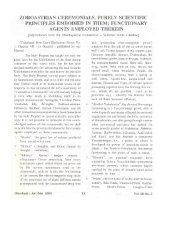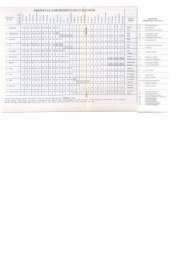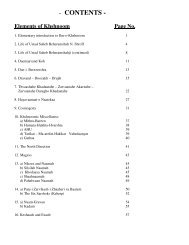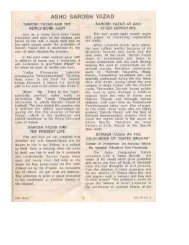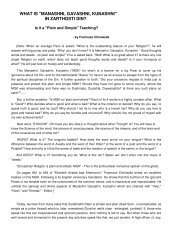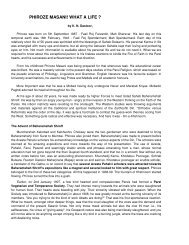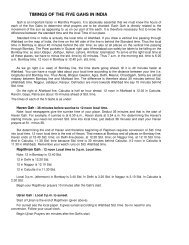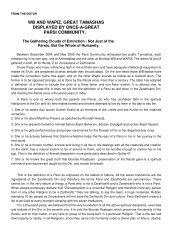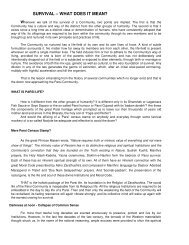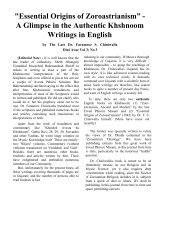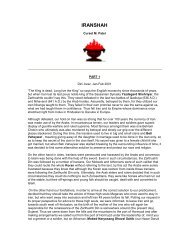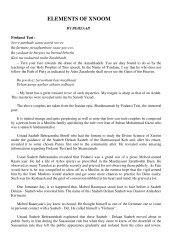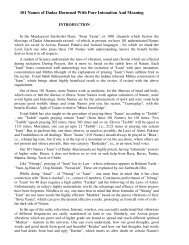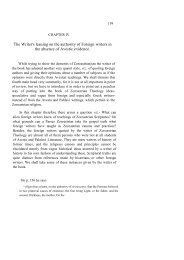the authentic key of ilm-e-khshnoom can alone open the door
the authentic key of ilm-e-khshnoom can alone open the door
the authentic key of ilm-e-khshnoom can alone open the door
You also want an ePaper? Increase the reach of your titles
YUMPU automatically turns print PDFs into web optimized ePapers that Google loves.
MITHRA, MANTHRA, YASNA, THE THREE<br />
MODES OF WRITING (KALAMKASHI).<br />
TAAVIL AND ZEND, THE TWO SUBDIVISIONS<br />
OF THE MITHRA MODE.<br />
Manthra and Yasna Modes Deal With Ahura's Creation<br />
Beyond Our Non-Saintly Experience.<br />
by Dr. Saheb Framroze Chiniwalla<br />
[Revision: Writing is a form <strong>of</strong> human expression. We write through a language. Languages are many.<br />
Modes <strong>of</strong> writing are different, like story, novel, drama, poetry, essay. All <strong>the</strong>se are intended to convey some<br />
ideas, some thought to <strong>the</strong> reader. There is what is known as, "style" in writing. A style is good, if it conveys<br />
<strong>the</strong> thought effectively. As Bernard Shaw wrote, "Effectiveness <strong>of</strong> assertion is <strong>the</strong> alpha and omega <strong>of</strong> style."<br />
In <strong>the</strong> ancient and more advanced science <strong>of</strong> words, languages and styles <strong>of</strong> writing, this kind <strong>of</strong> our daily or<br />
literary writing was called <strong>the</strong> Mithra mode <strong>of</strong> writing. But that ancient Science taught that <strong>the</strong>re are two o<strong>the</strong>r<br />
modes - Manthra and Yasna. Whereas <strong>the</strong> Mithra mode is related to <strong>the</strong> human understanding or absorption<br />
<strong>of</strong> <strong>the</strong> thought by ordinary non-saintly humans like us and is confined to <strong>the</strong> ideas or concepts or perception<br />
about <strong>the</strong> world <strong>of</strong> our day to day experience, <strong>the</strong> Manthra and Yasna modes, though consisting <strong>of</strong> spoken<br />
words, go beyond our ordinary thought. They emanate from <strong>the</strong> realms and regions beyond our<br />
consciousness. They <strong>the</strong>refore speak Mo<strong>the</strong>r Nature's mystical languages, and recite, narrate and chronicle<br />
things from beyond our thinking power or capacity.<br />
Dr. Saheb Framroze Chiniwalla is telling us about this ancient science <strong>of</strong> writing or Kalam-kashi. Kalam<br />
means pen and 'kashi' comes from 'Kashiden' to draw or pull. Draw your kalam like a sword, may it be made<br />
<strong>of</strong> sharp killing metal or <strong>of</strong> a garland <strong>of</strong> flowers. (Somebody did say: "<strong>the</strong> pen is mightier than <strong>the</strong> sword"; we<br />
may well say, <strong>the</strong> Pen <strong>can</strong> be s<strong>of</strong>ter than <strong>the</strong> flower.)<br />
This ancient science says that <strong>the</strong> Mithra mode is classified in two sub-modes: 'Tavil' mode and 'Zend'<br />
mode. Tavil mode is all our human writings which convey <strong>the</strong>ir thought easily and smoothly. Its intention is<br />
that <strong>the</strong> reader should quickly and effectively absorb it. Zend mode is not that simple; it conveys some ideas<br />
from beyond <strong>the</strong> frontiers <strong>of</strong> our consciousness, but in <strong>the</strong> words or language <strong>of</strong> our experience. It will talk <strong>of</strong> a<br />
cow, to express certain hidden forces or energies from <strong>the</strong> hidden realms <strong>of</strong> Nature. It will refer to a horse or<br />
camel to indicate certain hidden spiritual powers and energies hidden in <strong>the</strong> inner depth <strong>of</strong> <strong>the</strong> human<br />
personality. This means Zend mode is <strong>the</strong> explanatory or illustrative version <strong>of</strong> things beyond.<br />
The two modes, o<strong>the</strong>r than <strong>the</strong> Mithra mode, are: (i) Manthra and (ii) Yasna. They are way beyond us.<br />
They are <strong>the</strong> descriptions <strong>of</strong> Nature's secret working, and are intended to lift up a human's spiritual level and<br />
to expand its frontier <strong>of</strong> consciousness. They do have meanings and messages, but <strong>the</strong>y are required to be<br />
deciphered, and decoded. This <strong>can</strong>not be done, unless <strong>the</strong> person striving to understand <strong>the</strong>m have some<br />
idea <strong>of</strong> <strong>the</strong> mystical regions and energies beyond his consciousness.<br />
The ancient more advanced science says that <strong>the</strong>re is an Ilm, a branch <strong>of</strong> mystical Knowledge called<br />
"Staota Yasna". 'Staota' means, roughly, vibration. Vibration means a motion <strong>of</strong> a certain kind. The whole <strong>of</strong><br />
Ahura's creation is made up <strong>of</strong> vibrations, may it be a Yazata or an electron. All things <strong>of</strong> our experience on<br />
this earth are solidified or crystallised vibrations. Things in <strong>the</strong> non-physical and divine worlds are <strong>of</strong> different<br />
kinds <strong>of</strong> subtler and subtler motions or colours. Thus Staota Vibration is <strong>the</strong> foundation <strong>of</strong> all <strong>the</strong> basic laws <strong>of</strong><br />
Nature and its working. Yasna means all <strong>the</strong> Kriya that goes on in Nature. Avesta declares that in a pithy<br />
sentence written in <strong>the</strong> Manthra mode: "Staota Yasna Yazmaidey Ya Daataa Vangha-he-oosh Pauroo yeh<br />
yaa. (Yazashne Ha 54)" "We attune ourselves with Staota Yasna which are <strong>the</strong> First founding Laws <strong>of</strong> <strong>the</strong><br />
Creation."<br />
So, <strong>the</strong> Ilm <strong>of</strong> Staota Yasna which is <strong>the</strong> deciphering <strong>key</strong> <strong>of</strong> <strong>the</strong> Manthra and Yasna Words and Writings,<br />
has its source in those Founding Laws <strong>of</strong> Creation, which are <strong>the</strong>mselves also called Staota Yasna. Our



